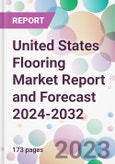Flooring plays a critical role in the aesthetics, comfort, and functionality of any space. In the U.S., the demand for varied flooring solutions, from hardwood and laminates to carpets and ceramic tiles, has been on an upward trajectory. The market reflects a blend of traditional preferences and contemporary trends, with an increasing shift toward environmentally friendly and easy-to-maintain flooring options.
The surge in residential construction, especially in fast-developing regions within the U.S., has been a cornerstone for the United States flooring market growth. Homeowners are increasingly looking for durable yet stylish flooring options, propelling the demand for luxury vinyl tiles (LVT) and engineered wood. Furthermore, the commercial sector, including offices, hospitality, and retail spaces, is seeking innovative, high-performance, and aesthetically pleasing flooring solutions, further accentuating the market dynamics. With growing awareness about environmental concerns, the market is witnessing a notable shift towards sustainable and eco-friendly materials, like bamboo, cork, and recycled flooring solutions.
As per the United States flooring market analysis, advancements in flooring technologies have introduced products that are more durable, scratch-resistant, and easy to install. Waterproof and pet-friendly flooring solutions are becoming increasingly popular among American households. Beyond functionality, the aesthetic appeal is driving choices in the flooring market. The versatility offered by ceramic tiles, the elegance of hardwood, and the comfort of carpets are influencing purchasing decisions.
The trend of renovating and retrofitting older homes and commercial spaces is another crucial factor propelling the United States flooring market demand. The increasing emphasis on health and hygiene, especially post the pandemic era, has heightened the demand for antimicrobial, easy-to-clean, and moisture-resistant flooring options.
As the U.S. economy continues to recover and grow, the construction industry's revival will inherently support the flooring market's expansion. Moreover, the increasing focus on sustainable living, coupled with the relentless pursuit of comfort and luxury, will ensure that innovative, green, and high-aesthetic flooring solutions see consistent demand, contributing to the United States flooring market size.
Market Segmentation
The market can be divided based on type and application.
Market Breakup by Type
- Resilient Flooring
- Vinyl
- Linoleum
- Rubber
- Others
- Non-Resilient Flooring
- Ceramic Tiles
- Wood and Laminate
- Carpet and Rugs
- Others
Market Breakup by Application
- Residential
- Non-Residential
Competitive Landscape
The report looks into the market shares, plant turnarounds, capacities, investments, and mergers and acquisitions, among other major developments, of the leading companies operating in the United States flooring market. Some of the major players explored in the report are as follows:- Mohawk Industries, Inc.
- Shaw Industries Group, Inc.
- Armstrong Flooring, Inc.
- Engineered Floor, LLC
- Mannington Mills, Inc.,
- The Dixie Group, Inc.
- Tarkett Group
- Others
Table of Contents
Companies Mentioned
- Mohawk Industries Inc.
- Shaw Industries Group Inc.
- Armstrong Flooring Inc.
- Engineered Floor LLC
- Mannington Mills Inc.
- The Dixie Group Inc.
- Tarkett Group
Methodology

LOADING...








